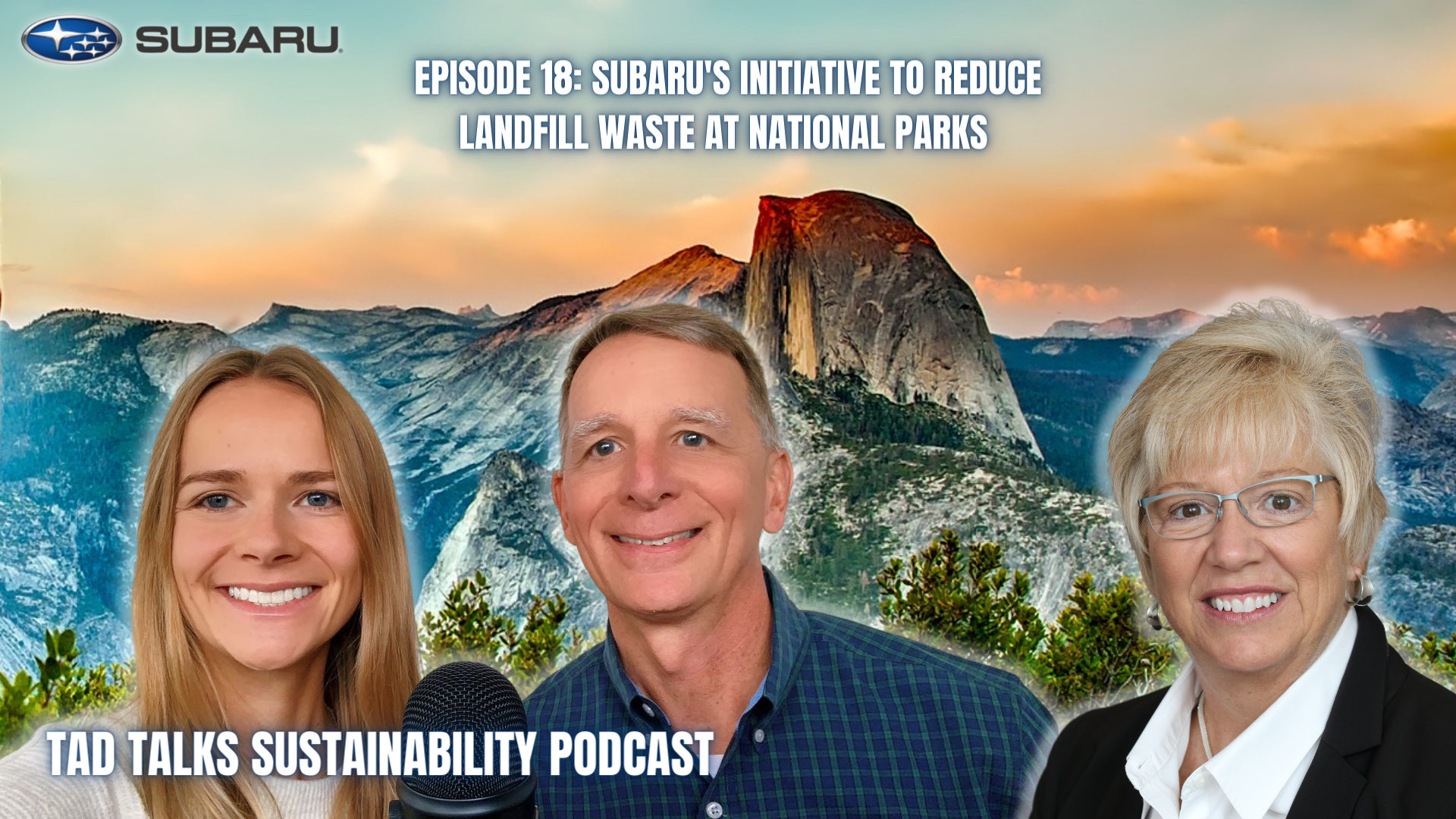Episode 18: A Roadmap to Reducing Waste with Denise Coogan from Subaru
Click the links below to listen to the full episode
Manufacturing cars can produce a ton of waste. Reducing manufacturing waste is essential for all companies in order to decrease environmental impact and save money. In this episode, Tad and Julianna sit down with Denise Coogan, Environmental Partnership Manager for Subaru of America, Inc, to discuss Subaru’s journey to reducing waste, how they got their employees on board with their zero waste to landfill journey, how they are supporting National Parks in minimizing their waste, how they have helped Subaru Park, the home of the Philadelphia Union, become the first Major League Soccer (MLS) stadium to achieve zero waste to landfill status, and what’s next for Subaru.
Subaru has had a long commitment to reducing waste and minimizing waste that goes to landfill. Can you tell us how you got started with this?
“Yes, so it started really in earnest in 2002. Subaru of Indiana always had a very good ethic about the environment, but in 2002, our corporate office came to the plant and they said, ‘I want you to be zero landfill in five years.’ This was when no one was doing that really, and we didn't really know even how to start. It was a 4.5 million square foot facility at the time, and there were about 3,700 employees there. Now there's close to there's over 6,000 of them there, and I think it's about a 5.5 million square foot facility in the heart of Indiana. We just didn't really know how to start, so we thought, ‘well, let's start with something we know.’
We know about soda pop cans, newspapers, paper, and things like that, so let's start collecting those. We put out containers and we got these fiber drums from the paint shop and we cleaned them up and we painted them. Everything was color coded: red was for pop cans, green was for bottles, and blue was for paper. We started telling our associates that we want to be the first manufacturing facility to become zero landfill. So in the cafeteria, we put up these huge posters. One looked like a pop can and the other one looked like a pop bottle. Every month we would measure how many that we had recycled kind of like that United Way thermometer.
People really started getting excited about it, and then we took that money that we got from the aluminum cans, and we gave it to a favorite charity that they could choose. So that really got the conversation started, and then we, we went to them and we said “out here on the manufacturing plant floor, what would you do to change the environment. What ideas do you have?’ We really gave people that opportunity to express themselves and to say, ‘here's my idea and I would really like to do this.’ They would give us these ideas and then we would implement them and we'd make sure the managers were included on it. Then we would quantify how much waste was being reduced, how much recycling was being done, and how much money was being saved. Then it really started to snowball down the hill. As more people realized that we were listening to them and that we were taking them seriously, then more ideas started coming in. We were given 5 years to make that goal of zero landfill, and we did it in 2.5 years.
May 4th, 2004, we sent our last load of material to a landfill, and since that time we've not sent anything. So when we started, we were generating 459 pounds of waste for every car that we built. Today, we're generating 210 pounds of trash or waste for every car that we build. So that 239 pounds of waste reduced is material that doesn't have to be extracted from the earth, produced, transported, stored, warehoused. used, sent out, paid to be sent out. So that really is where we want to be, designing for that sustainability and then reusing what we can.”
We know that you are doing a lot of work with the National Park Service. How are you supporting them and how are these programs going?
“It's been fun putting the principles that we learned at the Subaru plant in Indiana into effect in the national parks. The principles are all the same. It doesn't matter if you are doing manufacturing, or you're a legal office, or a hospital. Whatever you're doing, the principles stay the same. Finding out what you're generating, how much, where it's being generated, and finding the answers to those questions at the beginning is really important.
So that's what we did in our pilot program for the national park. We started with Denali National Park in Alaska, Grand Teton in Wyoming, and Yosemite in California. We started by including the community. So we invited all the community, the people who had the recycling centers, the landfills, chamber of commerce, schools, and of course the park service, and the national parks conservation association helped us with this. So everyone was involved with this to say, ‘how do we get this started now in the national parks?’ Subaru's support has been offering the expertise, and also offering grants every year. We gave these three parks the money to get started and several million dollars to get the things they needed.”
We know that you TEAMED up with the Philadelphia Union with the goal of making Subaru Park the first Zero Landfill stadium in the MLS. What steps did you take to achieve this?
“The same principles that we applied to the Subaru of Indiana and the National Parks, we applied to this Philadelphia Union stadium and they've been wonderful to work with. We had started that almost three years ago now, and we did the same thing. We took an inventory of what they're generating, and looked at line item by line item of what they ordered. I can tell you how many wooden spears they use for their sandwiches and all those things. Then we start looking at that to say, what can you switch out? What can be made compostable? How can we get rid of those plastic clam shells? Can we use aluminum beer cans instead of having plastic cups of draft beer. That was one of their biggest generators of waste.
By doing these kind of things, we're reducing the amount of waste that they're generating. Then we went in and used Max-R containers, they're made out of a recycled milk jugs, and we color coded them. They are separating plastic, composting and trash. And we have Subaru ambassadors that stand there to help people as they come out and say, ‘oh, that would be compost. Let's put that in there’. Then again, we're taking those measurements and we're looking at what waste we're generating.
October 23rd, 2021 it became a zero landfill stadium and the first Major League Soccer stadium to become zero landfill. So we're very proud of that. The Philadelphia Union and their management has been wonderful to work with the management at Subaru of America. It was very much a priority to them. Once it's a priority to the executives, it becomes a priority for everyone else. It's been a really great project and very fun.”
MORE VIDEO CONTENT
ABOUT Denise coogan
Denise Coogan is the Environmental Partnership Manager for Subaru of America, Inc. and is a recognized leader in zero waste programs. Coogan has worked for over 20 years developing the principles that are at the basis of most zero waste programs in existence today. Coogan uses her extensive knowledge of manufacturing facilities to build sustainability programs that reduce the collective environmental footprint and, at the same time, balance fiscal responsibility. The zero-landfill program that Coogan spearheaded at Subaru of Indiana Automotive, Inc. has won several awards, including the international Gro Brundtland Sustainia Award for developing a solution that will build a more sustainable future.
Coogan has developed a stellar reputation as having one of the most influential and inspiring voices on the lecture circuit, mentoring organizations around the globe to begin or enhance their sustainability programs. Through Coogan’s effort, more than 1,000 companies have reduced the amount of waste they generate, diverting tons of waste from the landfills. In her recent work with the National Park Service, Coogan is helping usher in an era of lasting sustainability practices that will change how the National Park units look at their sustainability efforts.
Coogan holds professional certifications as a Registered Environmental Manager (REM) and a Certified Hazardous Materials Manager (CHMM). She has an undergraduate degree in biology and a master’s degree in sustainable development and policy from the University of Illinois at Springfield.








